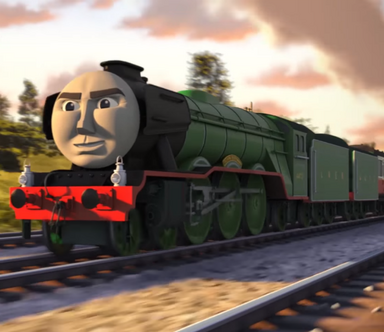
Flying Scotsman
Flying Scotsman, an LNER Class A3 Pacific, is the last of Gordon's brothers. He holds the record for being the first engine to officially run at 100 mph. In addition, Flying Scotsman has been described as the world's most famous steam locomotive. He got his name because he ran from London, England all the way to Edinburgh, Scotland.
History[]
Flying Scotsman was completed in 1923, construction having been started under the auspices of the Great Northern Railway. He was built as an A1, initially carrying the number 1472.
Flying Scotsman was something of a flagship locomotive for the LNER. He represented the company at the British Empire Exhibition at Wembley in 1924 and 1925. At this time he acquired his name and the new number of 4472. From then on he was commonly used for promotional purposes.
With a suitably modified valve gear, he was one of five Gresley Pacifics selected to haul the prestigious non-stop Flying Scotsman train service from London to Edinburgh, hauling the inaugural train on 1 May 1928. For this, the locomotives ran with a new version of the large eight-wheel tender which held nine tons of coal. This and the usual facility for water replenishment from the water trough system enabled them to travel the 631 kilometres from London to Edinburgh in eight hours non-stop. The tender included a corridor connection and tunnel through the water tank giving access to the locomotive cab from the train in order to allow replacement of the driver and fireman without stopping the train. The following year he appeared in the film "The Flying Scotsman".
On 30 November 1934, running a light test train, he became the first steam locomotive to be officially recorded at 100 mph and earned a place in the land speed record for railed vehicles; the publicity-conscious LNER made much of the fact.
On 22 August 1928, there appeared an improved version of this Pacific type classified A3; older A1 locomotives were later rebuilt to conform. On 25 April 1945, A1 class locomotives not yet rebuilt were reclassified A10 in order to make way for newer Thompson and Peppercorn Pacifics. This included Flying Scotsman, which emerged from Doncaster works on 4 January 1947 as an A3 having received a boiler with a long "banjo" dome of the type it carries today. By this time he had become renumbered as 103 in Edward Thompson's comprehensive renumbering scheme for the LNER, then 60103 from 1 January 1948 on the nationalisation of the railways when all the LNER locomotive numbers were prefixed with 60000. Between 5 June 1950 to 4 July 1954 and 26 December 1954 to 1 September 1957, under British Railways ownership, he was allocated to Leicester Central Shed on the Great Central, running Nottingham Victoria to London Marylebone services via Leicester Central and hauled one of the last services on that line before its closure. All A3 Pacifics were subsequently fitted with a double Kylchap chimney to improve performance and economy. This caused soft exhaust and smoke drift that tended to obscure the driver's forward vision; the remedy was found in the German-type smoke deflectors fitted from 1960, which somewhat changed his appearance but successfully solved the problem.
Biography[]
The Railway Series[]
In 1967, Flying Scotsman came to Sodor to cheer up his only surviving brother, Gordon. He had two tenders at the time he arrived, causing Henry to feel jealous. During his visit, he got on well with most of the Fat Controller's Engines and took charge of "the Limited" in place of Bear when Henry rescued both him and 199 as both diesels failed. After his visit, Flying Scotsman left with his enthusiasts when the Fat Controller announced that steam engines will still be at work on the North Western Railway.
Gordon later said that Flying Scotsman told him about the Silver Jubilee.
Thomas & Friends[]
Flying Scotsman (his name is not mentioned) visits Sodor and his two tenders appeared emerging out of Knapford Harbour station. The engines admired his two tenders (except Henry), which the Fat Controller said were due to long distances between coaling depots. Flying Scotsman is not referred to by name and Gordon does not appear to recognize him.
Much later, Flying Scotsman met Thomas at Vicarstown station, where he told him and Gordon that he had been invited to participate in the Great Railway Show on the Mainland. At the show, he saw Gordon in his streamlined form and was shocked, but still started to tease Gordon. He later competed in the Great Race, alongside Gordon, Spencer, Axel and Etienne. During the race, Flying Scotsman tried to warn Gordon that he was overheating, but Gordon paid no attention to him until his boiler had burst and he could not finish the race. Despite trying hard to win, he finished the race fourth. At the end of the Great Railway Show, Flying Scotsman and Gordon returned to the yard, where he admitted to Gordon that his view on Sudrian engines had improved since their race.
Flying Scotsman was the first engine to encounter Ace and had to avoid him running on the tracks instead of the road. Later that day, when Thomas tricked Gordon into taking his fish trucks for him at the back of the express, Flying Scotsman commented on the smell, jokingly wondering whether it was coming from Gordon or the fish. This sent Gordon screaming in rage at Thomas’ stunt.
When Rebecca was new to Sodor, she arrived too early at Vicarstown and almost took his passengers by mistake. Flying Scotsman questioned who was behind him, sarcastically thinking it was Gordon. He then preceded to tease Gordon, calling him "little brother". Later that same evening, Flying Scotsman arrived back at Vicarstown and called Gordon "little brother" again. As a result, Rebecca commented on how she thought Gordon may be a bit bigger, leaving Flying Scotsman gobsmacked.
Personality[]
In the Railway Series, Gordon was happy to see Flying Scotsman when he came to Sodor. Flying Scotsman proved popular with the engines, however, did spark a little jealousy with Henry, who proved envious of his two tenders. He provided Gordon and the others reassurance at a time when steam on the Mainland was officially being abolished in favour of modern diesel traction.
In the television series, Flying Scotsman is a polite and proud engine; however he can be pompous and somewhat smug, like his brother Gordon. Despite being friendly with Thomas and giving him a pep talk, he thought that no famous engines came from Sodor and indicated that he viewed Sudrian engines with low expectations. He later changed his mind after seeing the Sudrian engines competing at the Great Railway Show, realising they were made of "sterner stuff" than he initially believed. Additionally, after meeting Rebecca for the second time, her opinion on the "little brother" status left something he never expected while giving Gordon a big laugh at the same time.
Flying Scotsman has a common sibling relationship with Gordon, and enjoys teasing him, referring to him as his "little brother" to annoy him, using his catchphrase as his own, or bragging about being invited to the Great Railway Show. He does care for him though, as shown when Gordon was overheating during the race and Flying Scotsman urgently warned him to stop.
Preservation[]
60103 ended service with British Railways in 1963 and was sold for preservation to Alan Pegler, who had him restored as closely as possible to his original LNER condition. He then worked a number of rail-tours, including a non-stop London–Edinburgh run in 1968 – the year steam traction officially ended on BR. As watering facilities for locomotives had by then disappeared, a second eight-wheel tender was adapted as an auxiliary water tank.
In 1969, he went on a promotional tour to the USA, where he was fitted with a cowcatcher, a high-intensity headlamp, a bell, air brakes and buckeye couplings. The trip was initially a success, but when Pegler's backers withdrew their support he began to lose money and was finally bankrupted in 1972. Fears then arose for his future, the speculation being that he could take up permanent residence in America or even be cut up. Fortunately, in January 1973 William McAlpine stepped in at the eleventh hour and had him repaired and repatriated.
In 1988, Flying Scotsman travelled to Australia to take part in the country's bicentenary celebrations. There, he set another record, travelling 442 miles/711 kilometres from Parkes to Broken Hill non-stop, the longest such run by a steam locomotive ever recorded.
In recent years, Flying Scotsman has continued to have an eventful existence. In 1995 he was in pieces at Southall depot in West London and facing an uncertain future owing to the cost of restoration and refurbishment necessary to meet the stringent engineering standards required for main line operation. Salvation came in 1996 when Dr. Tony Marchington bought him and had him restored to running condition at a cost of some £750,000. During his overhaul between 1996 and 1999, Flying Scotsman's vacuum brakes were removed and replaced with air brakes.
In 2004, Flying Scotsman was put up for sale because of the mounting debts of its owning company. After a high-profile campaign, he was bought in April by the National Railway Museum in York and is now part of the national collection. Between 2006-16, Flying Scotsman underwent a major overhaul at the NRM and was originally due to resume running in summer 2011. The overhaul took much longer than expected due to the National Railway Museum's decision to rebuild Flying Scotsman's "spare" A3-type boiler rather than rebuilding his A4-type boiler, which he had fitted in his last overhaul between 1996 and 1999. The copper inner firebox from Flying Scotsman's "spare" boiler was rebuilt - only for the engineers to discover some faulty welds, which meant that it was sent back to the boiler works in Devon to be mended again. Also, a decision had been made to replace the air brakes with more effective vacuum brakes.
In February 2011, Flying Scotsman was nearing the end of his extensive and expensive overhaul when his boiler passed its steam test. Nearing completion of reassembly at the East Lancashire Railway's workshops in Bury, he was repainted in wartime black carrying two numbers "103" and "502" and sent to the National Railway Museum for a public launch on 27 May 2011 on the Great Hall's turntable.
However, Flying Scotsman returned to Bury, Lancashire for his reassembly to be completed - only for the engineers to discover that, when they were carrying out the fitting of the air brake system, there were five cracks in the hornblocks (metal inserts in the frames to guide the axleboxes). As a result, Flying Scotsman was again dismantled with his frames lifted from his wheels so that an ultrasonic test on the frames could be carried out. Unfortunately, more cracks had been discovered in the main frame stretcher, which required the boiler to be lifted out of the frames. This latest setback meant that Flying Scotsman would not be back in steam until April 2012 as originally planned. In July and August 2011, the National Railway Museum banned photography of Flying Scotsman as a result of these setbacks. However, the ban was lifted on 30 September 2011 when the National Railway Museum held a press conference at Bury where it was announced that an investigation was launched to find out why the cracks in the frames were not discovered before.
In the midst of Flying Scotsman's setback, Doctor Tony Marchington, Flying Scotsman's third owner (1996-2004), sadly passed away aged 55 on 16 October 2011. This was closely followed by the passing of Alan Pegler, Flying Scotsman's first owner (1963-1972), on 18 March 2012, aged 91.
Flying Scotsman took part at Railfest in the first week of June 2012. However, he missed out on the Barrow Hill Eastern Region-themed gala in April, as well as the Olympic Torch relay in the third week of June 2012 as further work had mounted up on his over-running and highly expensive overhaul.
Flying Scotsman's appearance at Railfest received mixed reviews, as he was still in his wartime black livery, but without his side rods. Following his appearance at Railfest, Flying Scotsman was put back inside the museum's workshop to be completed. On 26 October 2012, an inquiry report investigating Flying Scotsman's troublesome overhaul was published. The investigation discovered failings at every level of the overhaul due to the lack of an overhaul plan, which has been considered a massive embarrassment for the National Railway Museum (NRM).
Sadly, prior to Christmas 2012, another major mechanical flaw was found on Flying Scotsman - his middle cylinder was discovered to be out of alignment by half an inch. This resulted in Flying Scotsman being dismantled for a fourth time. On March 2013, another report produced by First Class Partnerships declared that Flying Scotsman's lengthy overhaul would not be finished until 2015.
In October 2013, Flying Scotsman's chassis had once again been sent to Bury, Lancashire for further restoration (his boiler and tender remained in the National Railway Museum). A month later, his chassis successfully passed an ultrasonic test (no cracks found in the chassis), meaning that further work on the cylinders can once again progress.
Flying Scotsman returned to steam on 7 January 2016 at the East Lancashire Railway with a series of test runs following. A return to main line service and an official inaugural run between King's Cross and York followed a month later.
Trivia[]
- The Flying Scotsman's face is a modified version of Gordon's.
- Flying Scotsman meet Twilight Sparkle, The Wild Kratts, Lightning McQueen, Dusty Crophopper, Wilson, Brewster, Koko and their friends in Twilight Sparkle's Adventures of Thomas & Friends: The Great Race. He'II be surprised that Rainbow Dash is Gordon's marefriend and likes her immediately, especially when he thought that she'II be his sister-in-law in the future, showing that he supports his brother's love for Rainbow Dash.
- Flying Scotsman guest star in Thomas' Adventures of My Little Pony Friendship is Magic- Top Bolt.
- Flying Scotsman appear again in Thomas and Twilight Sparkle Meets Paddington where he's leading Gordon, Thomas, Twilight and their friends to Paddington station in London from Vicarstown.
- In The Great Race, Flying Scotsman is incorrectly depicted with his tender having six wheels instead of eight.
- The CGI model of Flying Scotsman has three axles on his tenders, unlike the real Flying Scotsman, which has four.
- His headlamps changed from white to silver in Big World! Big Adventures!
- Flying Scotsman calls Gordon "Little Brother" despite the fact that Gordon is older than him, because Flying Scotsman was built in 1923 while Gordon was built in 1922 as a prototype pacific. The nickname's origin may come from his extra tender, giving Flying Scotsman extra mass compared to his brother.
- Flying Scotsman is the only real world locomotive to appear in full CGI.
Gallery[]

Flying Scotsman in the TV series
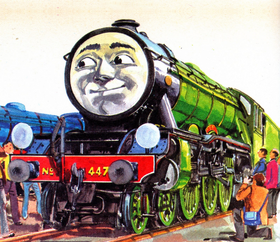
Flying Scotsman in the RWS

Flying Scotsman with Thomas in The Great Race

Flying Scotsman's tenders in CGI

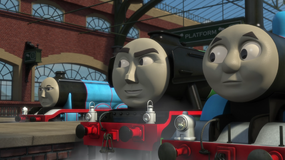

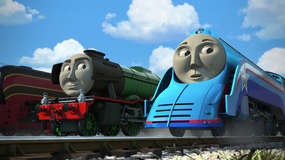





Flying Scotsman in Journey Beyond Sodor

Flying Scotsman with Ace in Big World! Big Adventures!





Flying Scotsman in Season 22


Flying Scotsman with Gordon

Rebecca, Flying Scotsman and Gordon


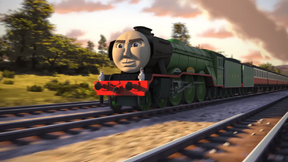
Flying Scotsman in the UK

Flying Scotsman in the Great Railway Show